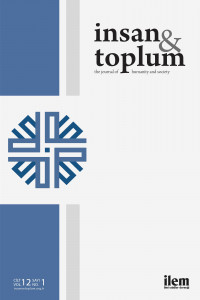Abstract
Küresel iklim değişikliğinin hız kazanması ve etkilerinin her geçen gün daha fazla hissedilmesi, araştırmacıların beşerî faaliyetlerin çevre üzerindeki etkilerine odaklanmasına yol açmaktadır. Bu çalışmada, Türkiye’nin çevresel kalitesini değerlendirmek amacıyla ekonomik büyüme, enerji kullanımı ve doğurganlık oranının ekolojik ayak izi ve biyolojik kapasite üzerindeki etkisi ARDL modeli ile incelenmiştir. 1970-2016 döneminin ele alındığı çalışmada, ekonomik büyüme ve çevresel kalite arasındaki ilişkinin ortaya çıkarılması için Çevresel Kuznets Eğrisi (Environmental Kuznets Curve) hipotezi test edilmiş ve hipotezin Türkiye için geçerli olduğu sonucuna varılmıştır. ARDL modeli ile seriler arasında eşbütünleşme ilişkisi tespit edildikten sonra uzun dönem katsayıları tahmin edilmiştir. Uzun dönem katsayı sonuçlarına göre enerji kullanımının ekolojik ayak izini pozitif, biyolojik kapasiteyi negatif etkilediği saptanmıştır. Bu durum, enerji kullanımının çevresel bozulmalara sebep olduğunu göstermektedir. Doğurganlık oranının ise ekolojik ayak izi ve biyolojik kapasite üzerinde pozitif bir etkiye sahip olduğu belirlenmiştir. Uzun dönem katsayıların tahmininin ardından hata düzeltme modelleri tahmin edilmiş ve bu modellerin sonuçlarına göre seriler arasında kısa dönemde ortaya çıkan dengeden sapmaların uzun dönemde denge noktasına yakınsadığı görülmüştür.
Keywords
Ekonomik büyüme Çevresel Kuznets Eğrisi hipotezi ekolojik ayak izi biyolojik kapasite ARDL modeli.
References
- Ali, W., Abdullah, A. ve Azam, M. (2017). Re-visiting the environmental Kuznets curve hypothesis for Malaysia: Fresh evidence from ARDL bounds testing approach. Renewable and Sustainable Energy Reviews, 77, 990-1000.
- Al-mulali, U., Weng-Wai, C., Sheau-Ting, L. ve Mohammed, A. H. (2015). Investigating the environmental Kuznets curve (EKC) hypothesis by utlilizing the ecological footprint as an indicator of environmental degradation. Ecological Indicators, 48, 315-323.
- Alola, A. A., Arikewuyo, A. O., Ozad, B., Alola, U. V. ve Arikewuyo, H. O. (2020). A drain or drench on biocapacity? Environmental account of fertility, marriage, and ICT in the USA and Canada. Environmental Science and Pollution Research, 27, 4032-4043.
Abstract
The acceleration of global climate change has led researchers to focus on the effects of human activities on the environment. This study investigates the possible impact of economic growth, energy use, and fertility rate on ecological footprint and biocapacity by the ARDL model to evaluate the environmental quality of Turkey for the period 1970-2016. Therefore, the paper tests the Environmental Kuznets Curve (EKC) hypothesis to reveal the relationship between economic growth and environmental quality. The findings point that the EKC hypothesis is valid for Turkey. After determining the cointegration relationship between the ARDL model and series, the long-term coefficients are estimated. The results show that energy use positively affects ecological footprint, while it negatively affects biocapacity. This means that energy use causes environmental degradation in terms of both ecological footprint and biocapacity. Besides, the study reaches that fertility rate positively affects both ecological footprint and biocapacity. The error correction results of the model indicate that the deviations from the equilibrium between the series in the short run converge to the equilibrium point in the long run.
Keywords
Economic growth Environmental Kuznets Curve hypothesis ecological footprint biological capacity ARDL model.
References
- Ali, W., Abdullah, A. ve Azam, M. (2017). Re-visiting the environmental Kuznets curve hypothesis for Malaysia: Fresh evidence from ARDL bounds testing approach. Renewable and Sustainable Energy Reviews, 77, 990-1000.
- Al-mulali, U., Weng-Wai, C., Sheau-Ting, L. ve Mohammed, A. H. (2015). Investigating the environmental Kuznets curve (EKC) hypothesis by utlilizing the ecological footprint as an indicator of environmental degradation. Ecological Indicators, 48, 315-323.
- Alola, A. A., Arikewuyo, A. O., Ozad, B., Alola, U. V. ve Arikewuyo, H. O. (2020). A drain or drench on biocapacity? Environmental account of fertility, marriage, and ICT in the USA and Canada. Environmental Science and Pollution Research, 27, 4032-4043.
Details
| Primary Language | Turkish |
|---|---|
| Subjects | Sociology |
| Journal Section | Research Articles |
| Authors | |
| Publication Date | March 22, 2022 |
| Published in Issue | Year 2022 Volume: 12 Issue: 1 |


